Techno-Economic Performance Analysis of a 40.1 kWp Grid-Connected Photovoltaic (GCPV) System after Eight Years of Energy Generation: A Case Study for Tochigi, Japan
Abstract
:1. Introduction
- Measure the actual energy generation acquired from the inverter of the GCPV system installed in Tochigi prefecture, Japan, over the year 2019.
- An analytical model with solar irradiation obtained from Power Data Access Viewer (PDAV) was developed to investigate and evaluate the efficiency of the GCPV system monthly and annual energy generation by comparing the simulated and measured energy acquired from the inverter.
- Analyze the techno-economic performance of the GCPV system after eight years of energy generation under actual weather conditions.
2. Photovoltaic (PV) Energy in Japan
2.1. The Feed-In-Tariff (FIT) System in Japan
2.2. The Rate of Feed-In-Tariff (FIT) Over the Years in Japan
3. GCPV System Description and Data Collection
3.1. GCPV System Location
3.2. Data Collection
3.3. The GCPV System Description
4. GCPV System Performance Analysis Parameters Description and Definition
4.1. Technical Analysis Parameters of GCPVS Performance: Description and Definition
4.1.1. Simulated Energy ()
4.1.2. Array Yield ()
4.1.3. Final Yield ()
4.1.4. Reference Yield ()
4.1.5. Performance Ratio ()
4.1.6. Capacity Utilization Factor ()
4.1.7. Array Capture Losses ()
4.1.8. System Losses ()
4.2. Economic Analysis Parameters of GCPVS Performance: Description and Definition
4.2.1. Levelized Cost of Energy ()
4.2.2. Energy Generation Sold Back to the Grid at Given FIT Rate
5. Technical and Economic Performance Analysis Results
5.1. Technical Analysis Performance Results
5.1.1. The Annual Energy
5.1.2. The Monthly Energy
5.1.3. Yields and Losses
5.1.4. Capacity Utilization Factor () and Performance Ratio ()
5.1.5. System Loss () and Array Capture Loss ()
5.2. Economic Analysis Performance Results
5.2.1. LCOE
- The payment period (k) of a GCPVS installation in Japan is 20 years [36].
- The GCPV system installation’s annual average energy output (38,071 kWh/year) is assumed to be constant over the project life.
- The initial or investment cost is 420,000 JPY/kW (5135,088 $/kW) [25], which means 16,867.200 JPY/kW (206,225 $/kW) for the GCPV system under this study (40.16 kWp).
- The annual operation and maintenance ( cost is estimated as 200,000 JPY/year (2445 $/year) [25], and this is assumed to be constant for 20 years.
5.2.2. Energy Generation Sold Back to the Grid at a Given FIT Rate
6. Discussion
6.1. Correlation Coefficient
6.2. Comparative GCPV Systems Performance
7. Conclusions
- The annual reference yield ( ), array yield () and final yield () of the GCPV system calculated 3.84 h/d, 2.98 h/d, and 2.59 h/d, respectively.
- The annual average of the GCPV system is characterized at 68.1 %. The annual average of the GCPV system is 10.61%. Table 6 shows that the performance of the present system is entirely satisfactory, and the value of and is comparable to other plants installed in India
- The GCPV system installation’s annual average energy output (38,071 kWh/year) is assumed to be constant over the project life with an average of 0.85 capture losses () and 0.39 system losses ().
Author Contributions
Funding
Institutional Review Board Statement
Informed Consent Statement
Data Availability Statement
Acknowledgments
Conflicts of Interest
Abbreviations
Nomenclature
| IEC | International |
| FIT | Feed-In Tariff |
| STC | Standard Test Conditions |
| DC | Direct Current |
| k | The payment period (in years) |
| GCPV | Grid-connected Photovoltaic |
| PDAV | Power Data Access Viewer |
| PV | Photovoltaic |
| AC | Alternative Current |
| n | The interest rate |
Greek Symbols
| The efficiency of the PV subsystem |
Superscripts and Acronyms
| The Simulated AC Energy | |
| The Peak Sunshine Hours | |
| The Solar Irradiation | |
| The Daily Simulated Energy | |
| The Annual Simulated Energy | |
| The DC energy output from a PV array | |
| The expected number of hours of operation in a given period for regular month | |
| The performance Ratio | |
| The Array Yield | |
| The Reference Yield | |
| The Array Capture Losses | |
| The capital recovery factor | |
| The Annual Operation and Maintenance Cost | |
| The simulated Daily FIT Sales Price | |
| The simulated Annual FIT Sales Price | |
| The Correlation Coefficient | |
| The Measured Average Energy of the PV System | |
| The Installed Capacity Power Output | |
| The Deration Factor of Energy | |
| The Solar Irradiation Under STC | |
| The Monthly Simulated Energy | |
| The day count of the month | |
| The Annual AC Energy Output of the System Injected to the Utility Grid | |
| The Rated Power | |
| The Capacity Utilization Factor | |
| The Final Yield | |
| The System Loss | |
| The Levelized Cost of Energy | |
| The Initial Cost | |
| The simulated FIT Sales Price | |
| The simulated Monthly FIT Sales Price | |
| The FIT Sales Price of the GCPV System | |
| The Simulated Average Energy of the PV System |
References
- Narkwatchara, P.; Ratanatamskul, C.; Chandrachai, A. Performance Analysis of Electricity Generation from Grid-Connected Photovoltaic System Using All-Sky Index for Smart City Projects in Thailand. Renew. Energy 2021, 171, 315–327. [Google Scholar] [CrossRef]
- Saleheen, M.Z.; Salema, A.A.; Mominul Islam, S.M.; Sarimuthu, C.R.; Hasan, M.Z. A Target-Oriented Performance Assessment and Model Development of a Grid-Connected Solar PV (GCPV) System for a Commercial Building in Malaysia. Renew. Energy 2021, 71, 371–382. [Google Scholar] [CrossRef]
- Zervos, A.; Lins, C. Renewables 2016 Global Status Report; REN21: Paris, France, 2016; ISBN 978-3-9818107-0-7. [Google Scholar]
- Zsiborács, H.; Hegedűsné Baranyai, N.; Csányi, S.; Vincze, A.; Pintér, G. Economic Analysis of Grid-Connected PV System Regulations: A Hungarian Case Study. Electronics 2019, 8, 149. [Google Scholar] [CrossRef] [Green Version]
- Tanaka, Y.; Chapman, A.; Sakurai, S.; Tezuka, T. Feed-in Tariff Pricing and Social Burden in Japan: Evaluating International Learning through a Policy Transfer Approach. Soc. Sci. 2017, 6, 127. [Google Scholar] [CrossRef] [Green Version]
- Dondariya, C.; Porwal, D.; Awasthi, A.; Shukla, A.K.; Sudhakar, K.; SR, M.M.; Bhimte, A. Performance Simulation of Grid Connected Roof Top Solar PV System for Small House Holds A Case Study of Ujjain, India. Energy Rep. 2018, 4, 546–553. [Google Scholar] [CrossRef]
- Vidal, H.; Rivera, M.; Wheeler, P.; Vicencio, N. The Analysis Performance of a Grid-Connected 8.2 KWp Photovoltaic System in the Patagonia Region. Sustainability 2020, 12, 9227. [Google Scholar] [CrossRef]
- Measurement Principles for Terrestrial Photovoltaic (PV) Solar Devices With Reference Spectral Irradiance Data. Available online: https://webstore.iec.ch/publication/61084 (accessed on 25 February 2021).
- Fouad, M.M.; Shihata, L.A.; Morgan, E.I. An Integrated Review of Factors Influencing the Perfomance of Photovoltaic Panels. Renew. Sustain. Energy Rev. 2017, 80, 1499–1511. [Google Scholar] [CrossRef]
- Abdullah, G.; Nishimura, H.; Fujita, T. An Experimental Investigation on Photovoltaic Array Power Output Affected by the Different Partial Shading Conditions. Energies 2021, 14, 2344. [Google Scholar] [CrossRef]
- Ibrahim, H.; Anani, N. Variations of PV Module Parameters with Irradiance and Temperature. Energy Procedia 2017, 134, 276–285. [Google Scholar] [CrossRef]
- Sarver, T.; Al-Qaraghuli, A.; Kazmerski, L.L. A Comprehensive Review of the Impact of Dust on the Use of Solar Energy: History, Investigations, Results, Literature, and Mitigation Approaches. Renew. Sustain. Energy Rev. 2013, 22, 698–733. [Google Scholar] [CrossRef]
- Marrasso, E.; Roselli, C.; Tariello, F. Comparison of Two Solar PV-Driven Air Conditioning Systems with Different Tracking Modes. Energies 2020, 13, 3585. [Google Scholar] [CrossRef]
- Kymakis, E.; Kalykakis, S.; Papazoglou, T.M. Performance Analysis of a Grid Connected Photovoltaic Park on the Island of Crete. Energy Convers. Manag. 2009, 50, 433–438. [Google Scholar] [CrossRef]
- Viitanen, J. Energy Efficient Lighting Systems in Buildings with Integrated Photovoltaics. Ph.D. Thesis, Aalto University, Espoo, Finland, 2015. [Google Scholar]
- Mariano, J.R.L.; Lin, Y.-C.; Liao, M.; Ay, H. Analysis of Power Generation for Solar Photovoltaic Module with Various Internal Cell Spacing. Sustainability 2021, 13, 6364. [Google Scholar] [CrossRef]
- Fichera, A.; Marrasso, E.; Sasso, M.; Volpe, R. Energy, Environmental and Economic Performance of an Urban Community Hybrid Distributed Energy System. Energies 2020, 13, 2545. [Google Scholar] [CrossRef]
- Ceglia, F.; Marrasso, E.; Roselli, C.; Sasso, M. Small Renewable Energy Community: The Role of Energy and Environmental Indicators for Power Grid. Sustainability 2021, 13, 2137. [Google Scholar] [CrossRef]
- Abdullah, G.; Nishimura, H. Photovoltaic Array Cleaning System Design and Evaluation. J. Energy Power Eng. 2021, 15, 248–251. [Google Scholar]
- Ustun, T.S.; Nakamura, Y.; Hashimoto, J.; Otani, K. Performance Analysis of PV Panels Based on Different Technologies after Two Years of Outdoor Exposure in Fukushima, Japan. Renew. Energy 2019, 136, 159–178. [Google Scholar] [CrossRef]
- New Energy and Industrial Technology Development Organization. Available online: https://www.nedo.go.jp/english/ (accessed on 9 April 2021).
- Earth Policy Institute–Building a Sustainable Future|Home. Available online: http://www.earth-policy.org/ (accessed on 5 April 2021).
- Arias, J. Solar Energy, Energy Storage and Virtual Power Plants in Japan. p. 172p. Available online: https://www.eu-japan.eu/sites/default/files/publications/docs/min18_1_arias_solarenergy-energystorageandvirtualpowerplantsinjapan.pdf (accessed on 31 January 2021).
- Tokyo Electric Power Company (TEPCO)|HOME. Available online: https://www.tepco.co.jp/en/hd/index-e.html (accessed on 3 March 2021).
- Agency for Natural Resources and Energy. Available online: https://www.enecho.meti.go.jp/en/ (accessed on 2 April 2021).
- Map-It|Japan Map Site. Available online: https://map-it.azurewebsites.net/en (accessed on 1 April 2021).
- POWER Data Access Viewer. Available online: https://power.larc.nasa.gov/data-access-viewer/ (accessed on 8 March 2021).
- Japan Meteorological Agency. Available online: https://www.jma.go.jp/jma/indexe.html (accessed on 11 March 2021).
- Nasukarasuyama Monthly Climate Averages. Available online: https://www.worldweatheronline.com/nasukarasuyama-weather/tochigi/jp.aspx (accessed on 3 March 2021).
- Elhadj Sidi, C.E.B.; Ndiaye, M.L.; El Bah, M.; Mbodji, A.; Ndiaye, A.; Ndiaye, P.A. Performance Analysis of the First Large-Scale (15 MWp) Grid-Connected Photovoltaic Plant in Mauritania. Energy Convers. Manag. 2016, 119, 411–421. [Google Scholar] [CrossRef]
- Malvoni, M.; Leggieri, A.; Maggiotto, G.; Congedo, P.M.; De Giorgi, M.G. Long Term Performance, Losses and Efficiency Analysis of a 960 KW P Photovoltaic System in the Mediterranean Climate. Energy Convers. Manag. 2017, 145, 169–181. [Google Scholar] [CrossRef]
- Kumar, N.M.; Yadav, S.K.; Chopra, S.S.; Bajpai, U.; Gupta, R.P.; Padmanaban, S.; Blaabjerg, F. Operational Performance of On-Grid Solar Photovoltaic System Integrated into Pre-Fabricated Portable Cabin Buildings in Warm and Temperate Climates. Energy Sustain. Dev. 2020, 57, 109–118. [Google Scholar] [CrossRef]
- Sharma, R.; Goel, S. Performance Analysis of a 11.2 KWp Roof Top Grid-Connected PV System in Eastern India. Energy Rep. 2017, 3, 76–84. [Google Scholar] [CrossRef]
- Murat Ates, A.; Singh, H. Rooftop Solar Photovoltaic (PV) Plant–One Year Measured Performance and Simulations. J. King Saud Univ. Sci. 2021, 33, 101361. [Google Scholar] [CrossRef]
- Ayompe, L.M. Measured Performance of a 1.72 kW Rooftop Grid Connected Photovoltaic System in Ireland. Energy Convers. Manag. 2011, 52, 816–825. [Google Scholar] [CrossRef] [Green Version]
- Congedo, P.M.; Malvoni, M.; Mele, M.; De Giorgi, M.G. Performance Measurements of Monocrystalline Silicon PV Modules in South-Eastern Italy. Energy Convers. Manag. 2013, 68, 1–10. [Google Scholar] [CrossRef]
- Mensah, L.D.; Yamoah, J.O.; Adaramola, M.S. Performance Evaluation of a Utility-Scale Grid-Tied Solar Photovoltaic (PV) Installation in Ghana. Energy Sustain. Dev. 2019, 48, 82–87. [Google Scholar] [CrossRef]
- Home: Bank of Japan. Available online: https://www.boj.or.jp/en/index.htm/ (accessed on 8 April 2021).
- Al-Badi, A.H. Measured Performance Evaluation of a 1.4 KW Grid Connected Desert Type PV in Oman. Energy Sustain. Dev. 2018, 47, 107–113. [Google Scholar] [CrossRef]
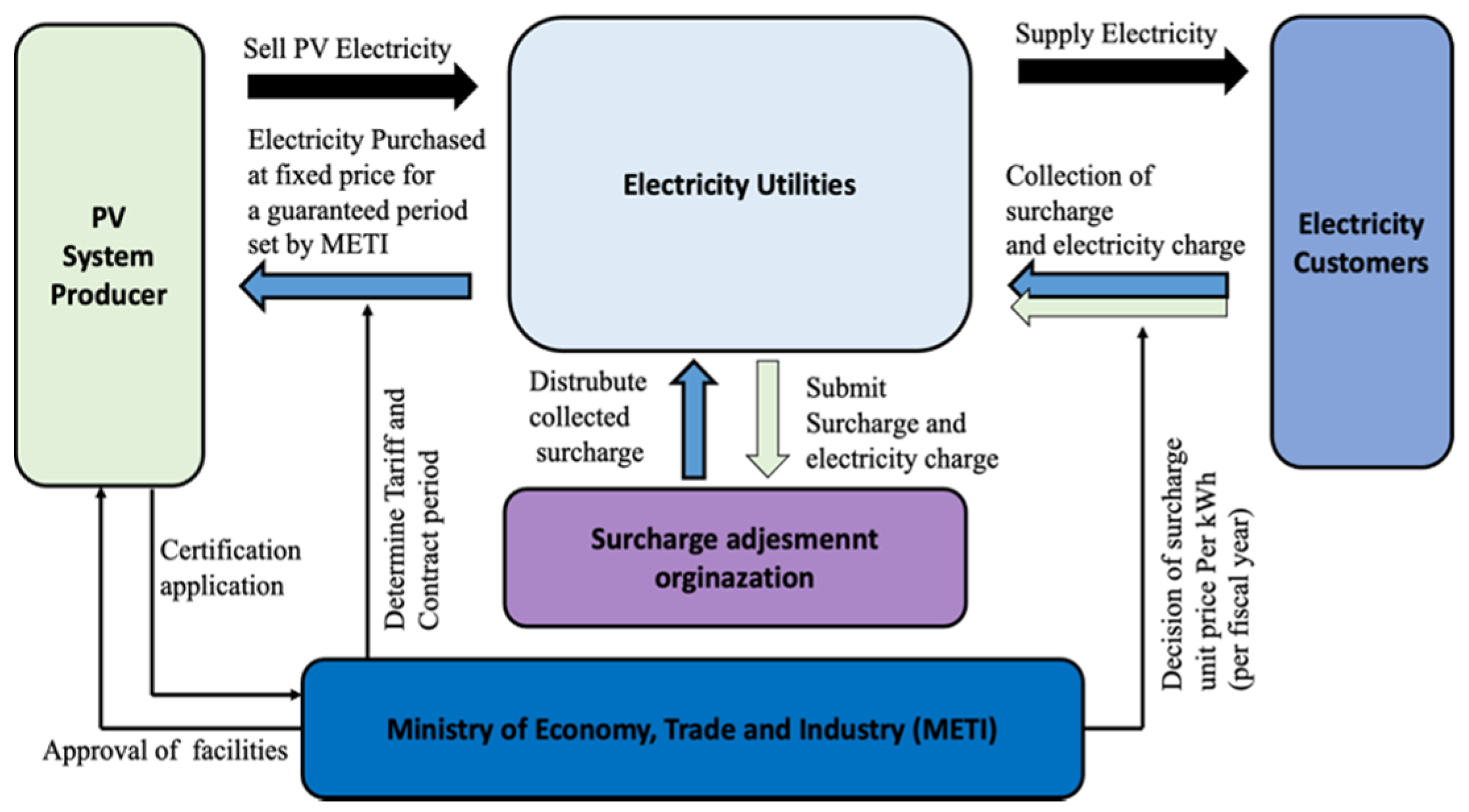
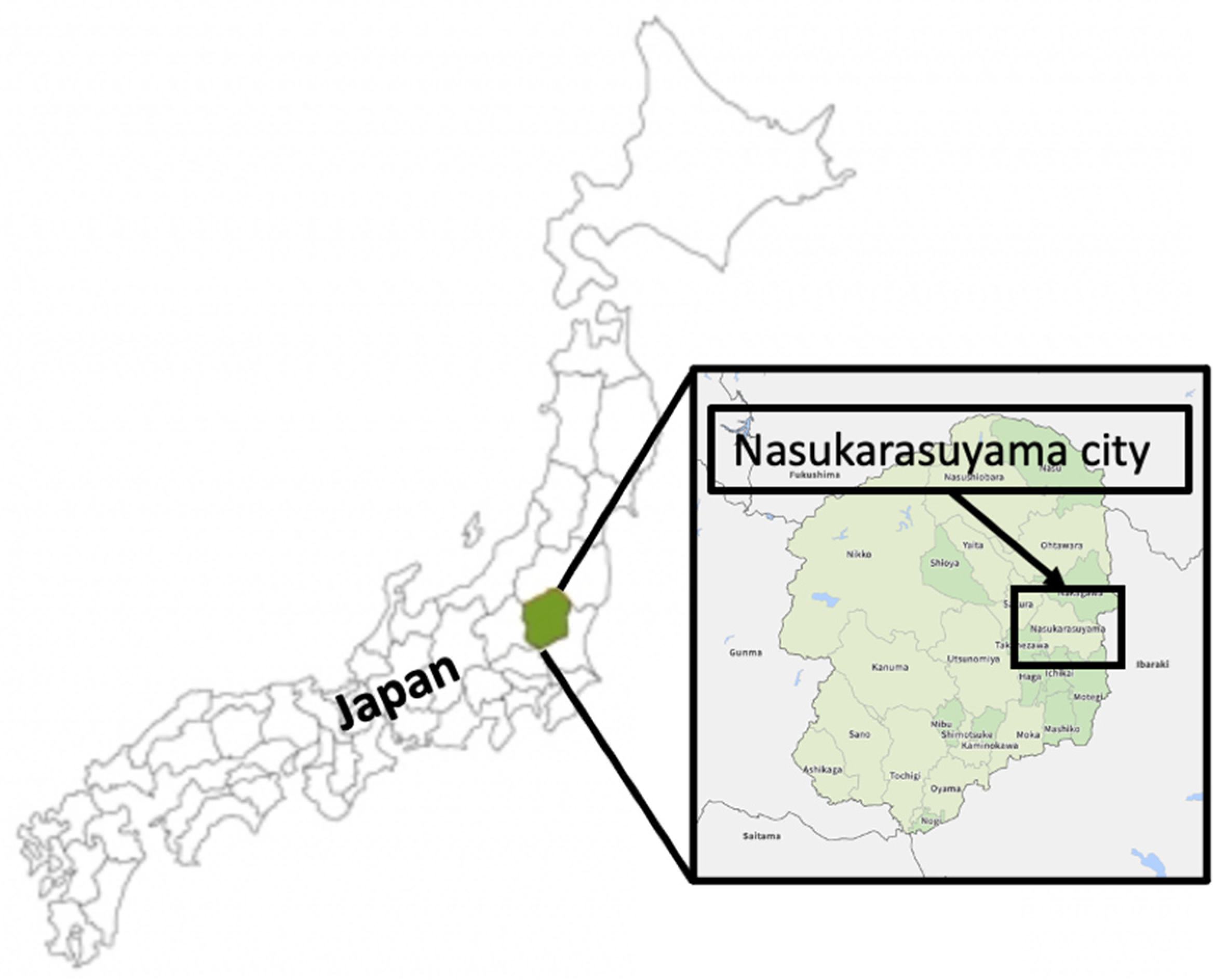
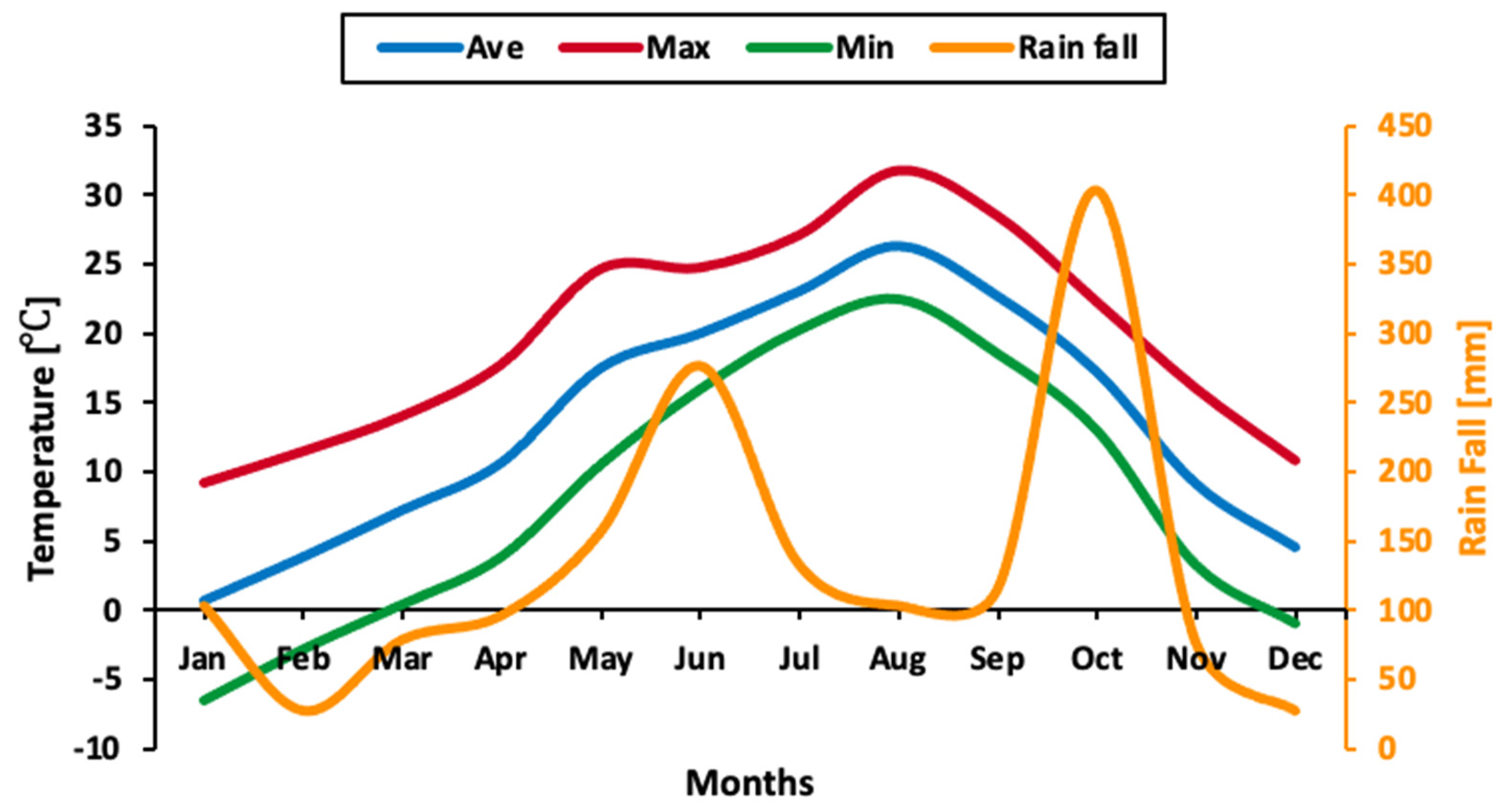
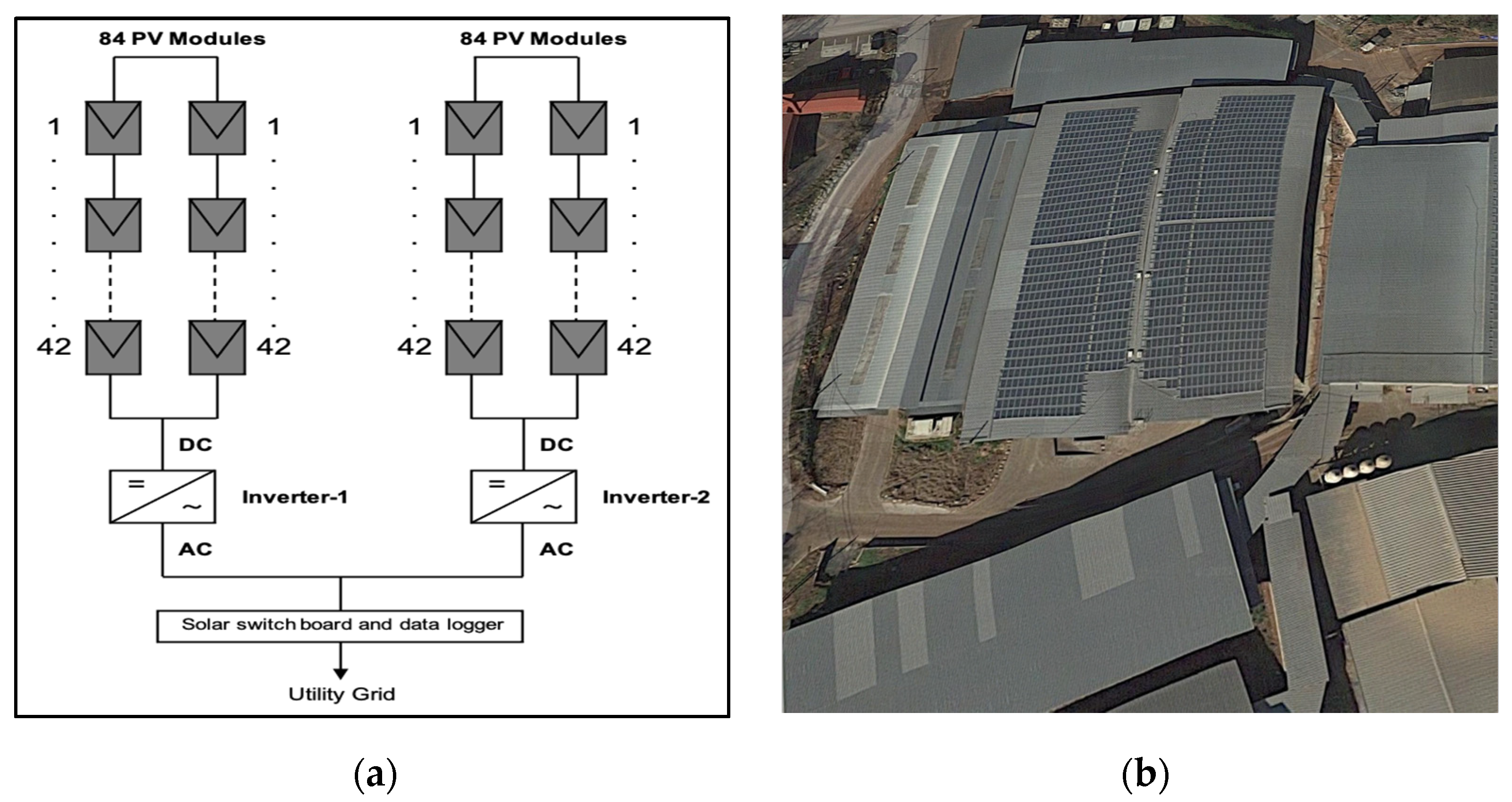
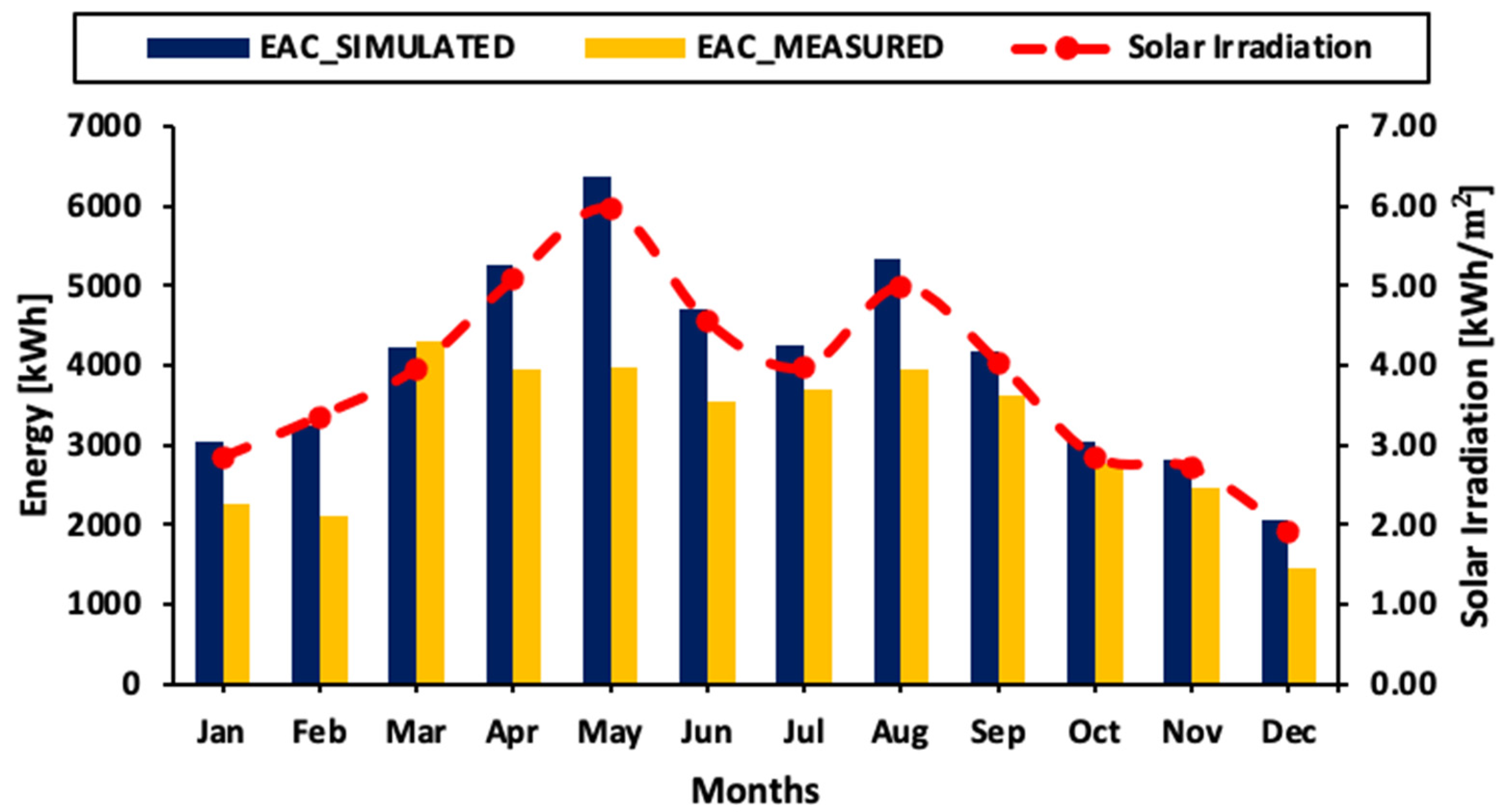
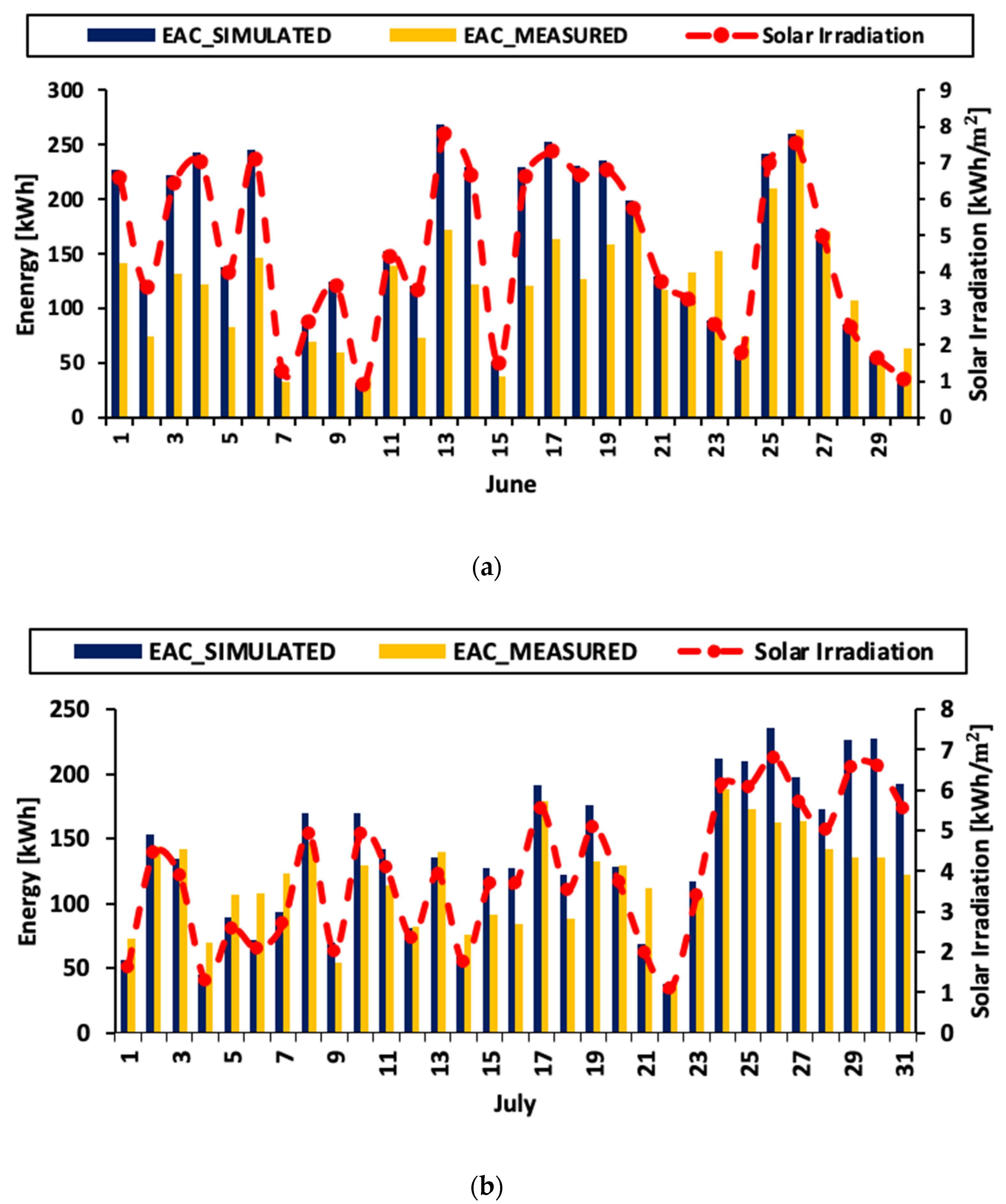
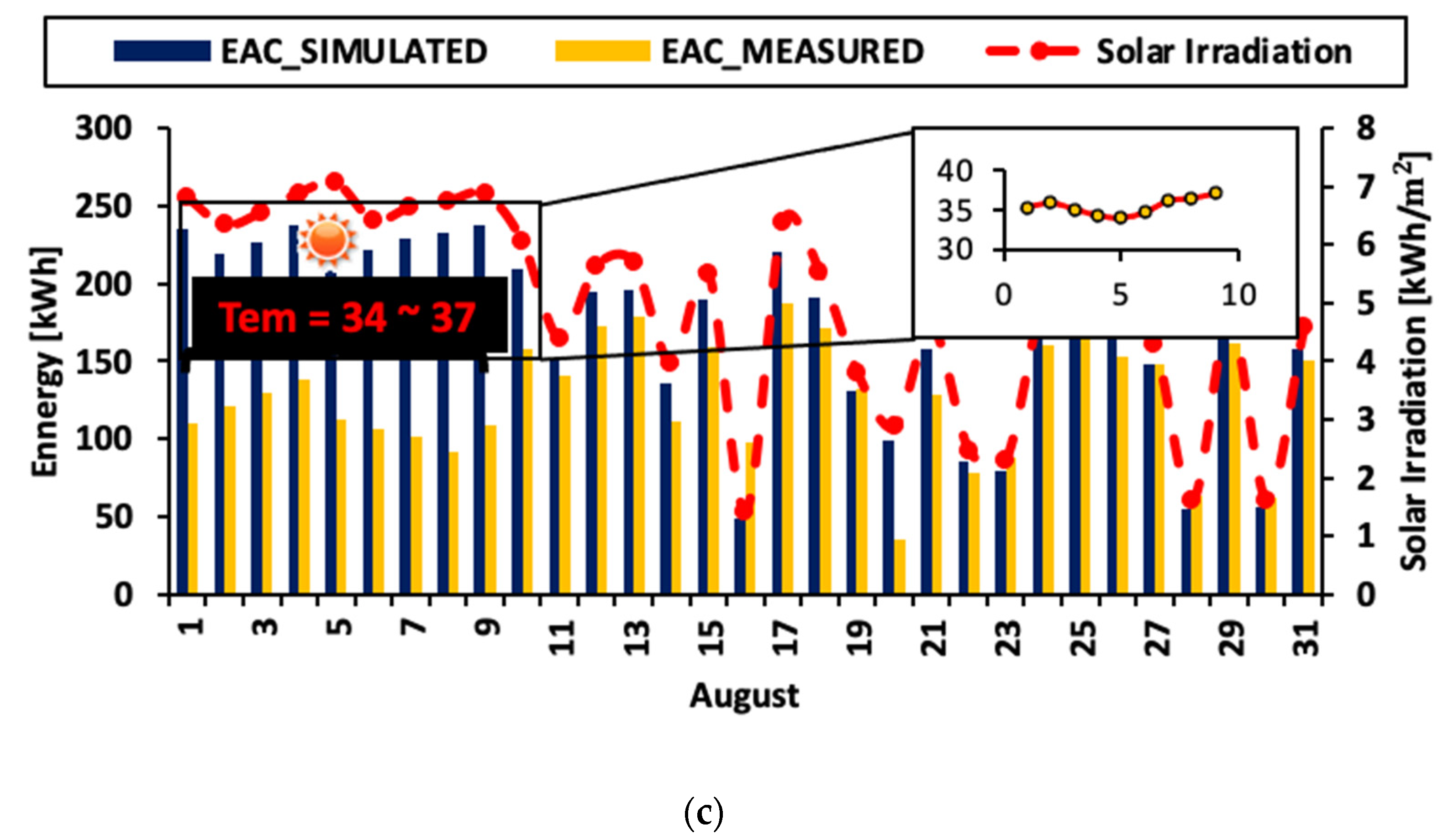
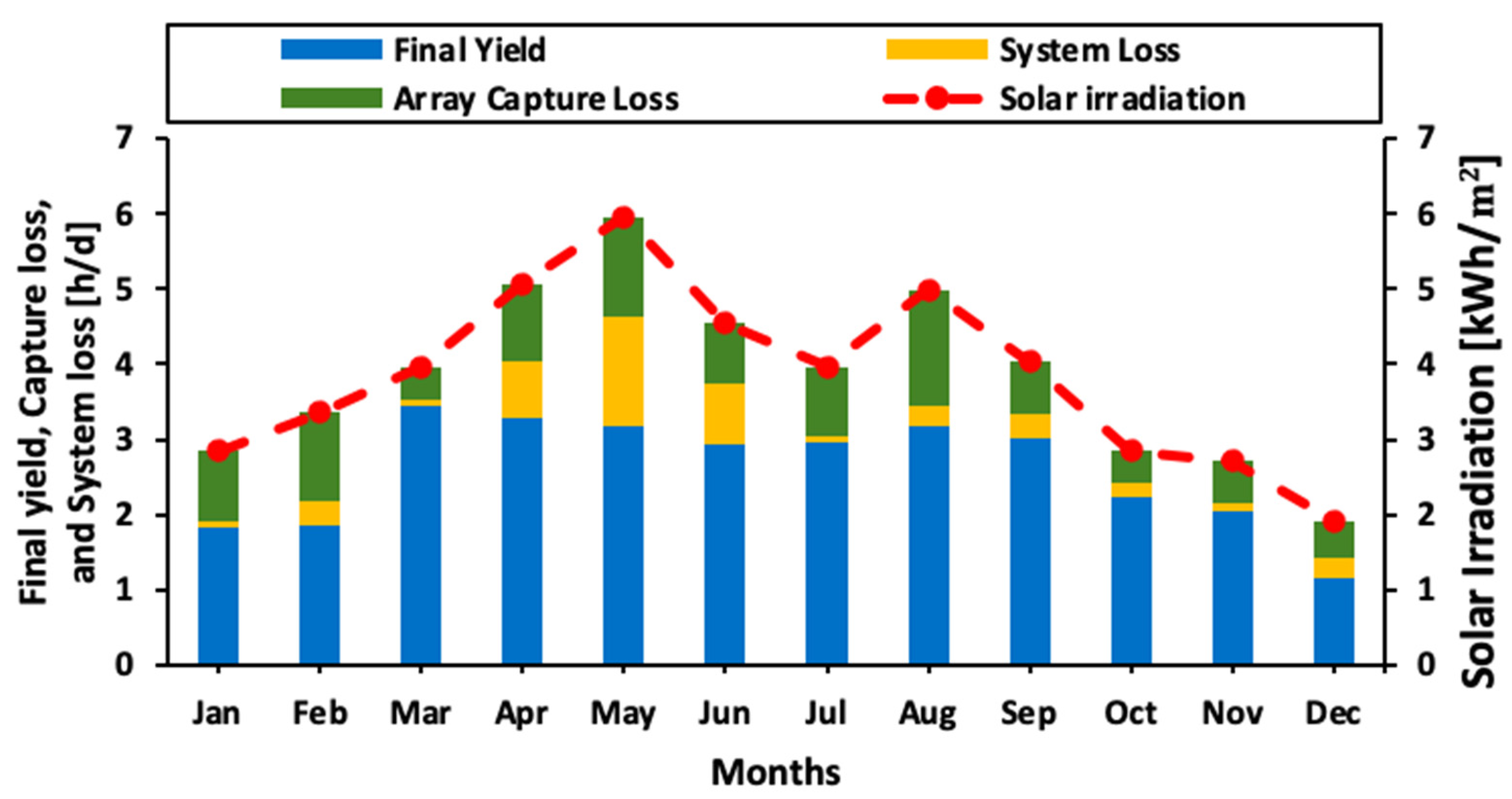
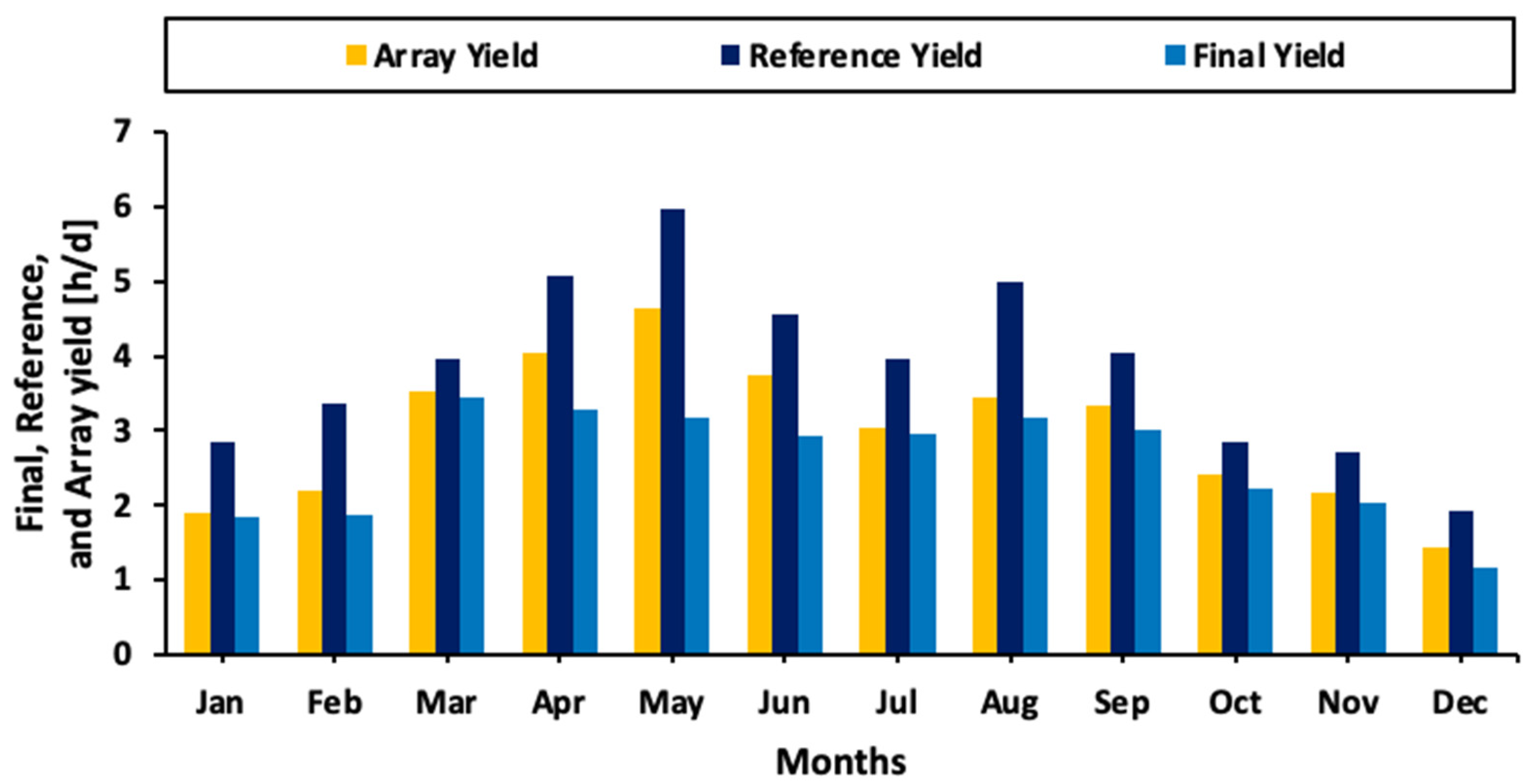
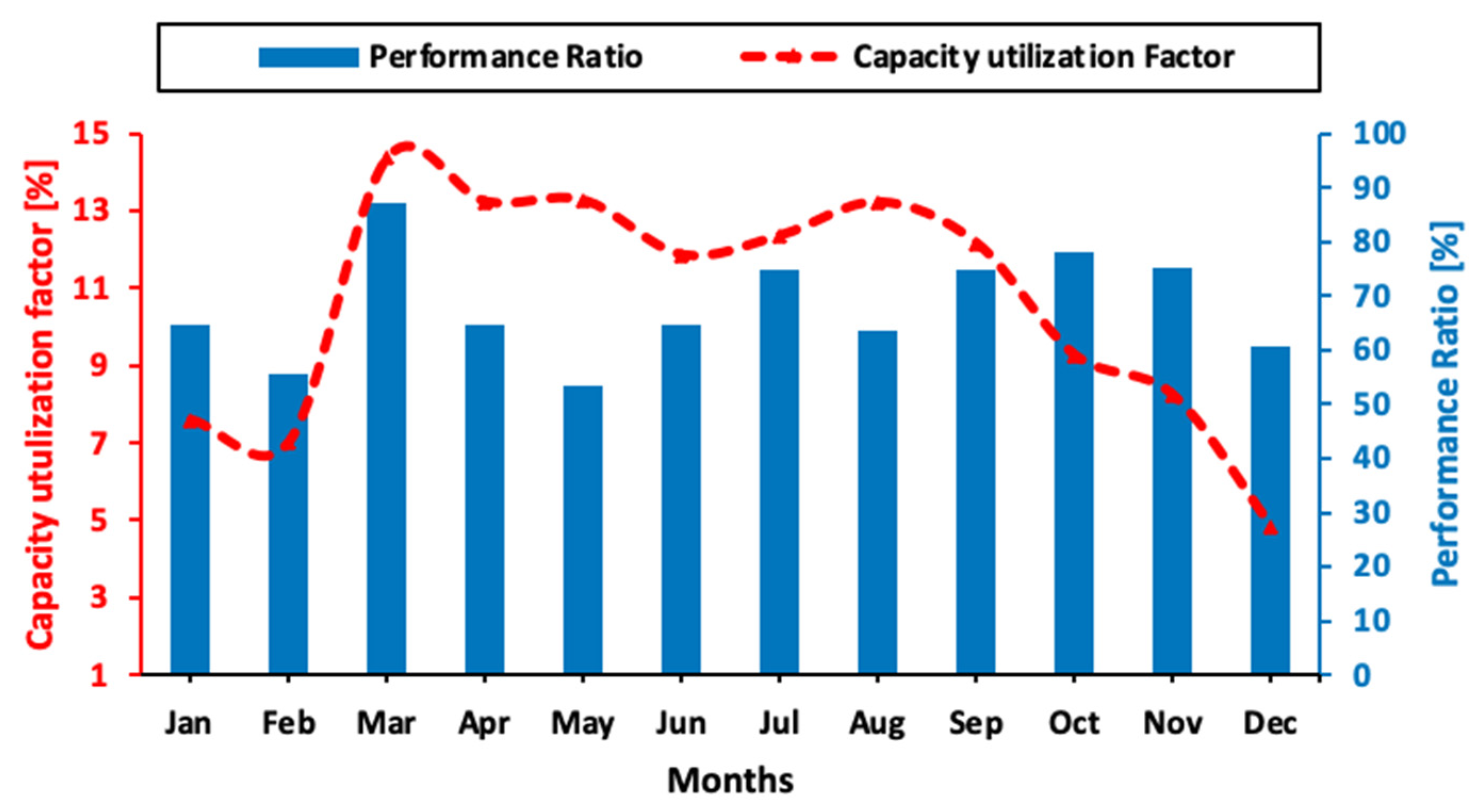
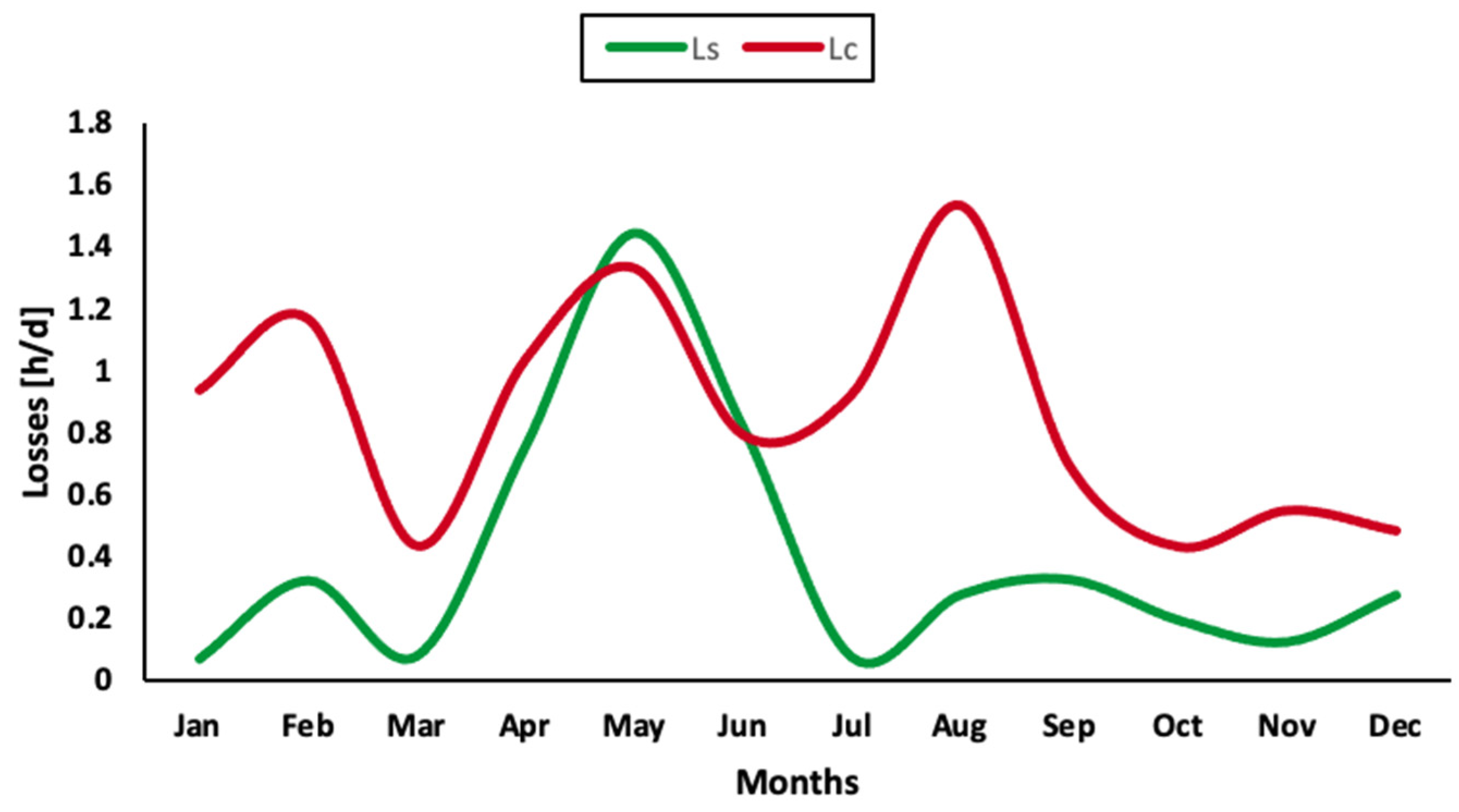
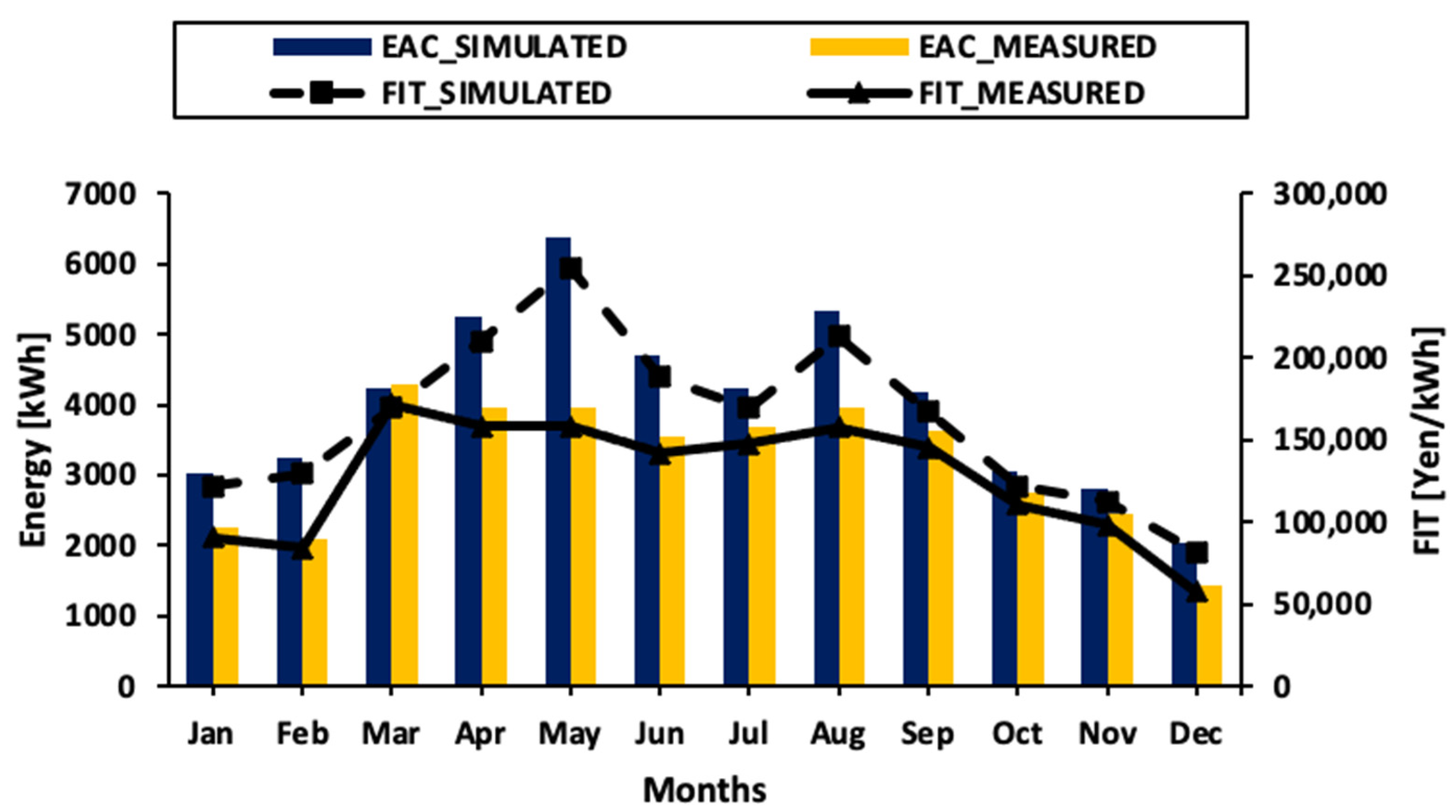
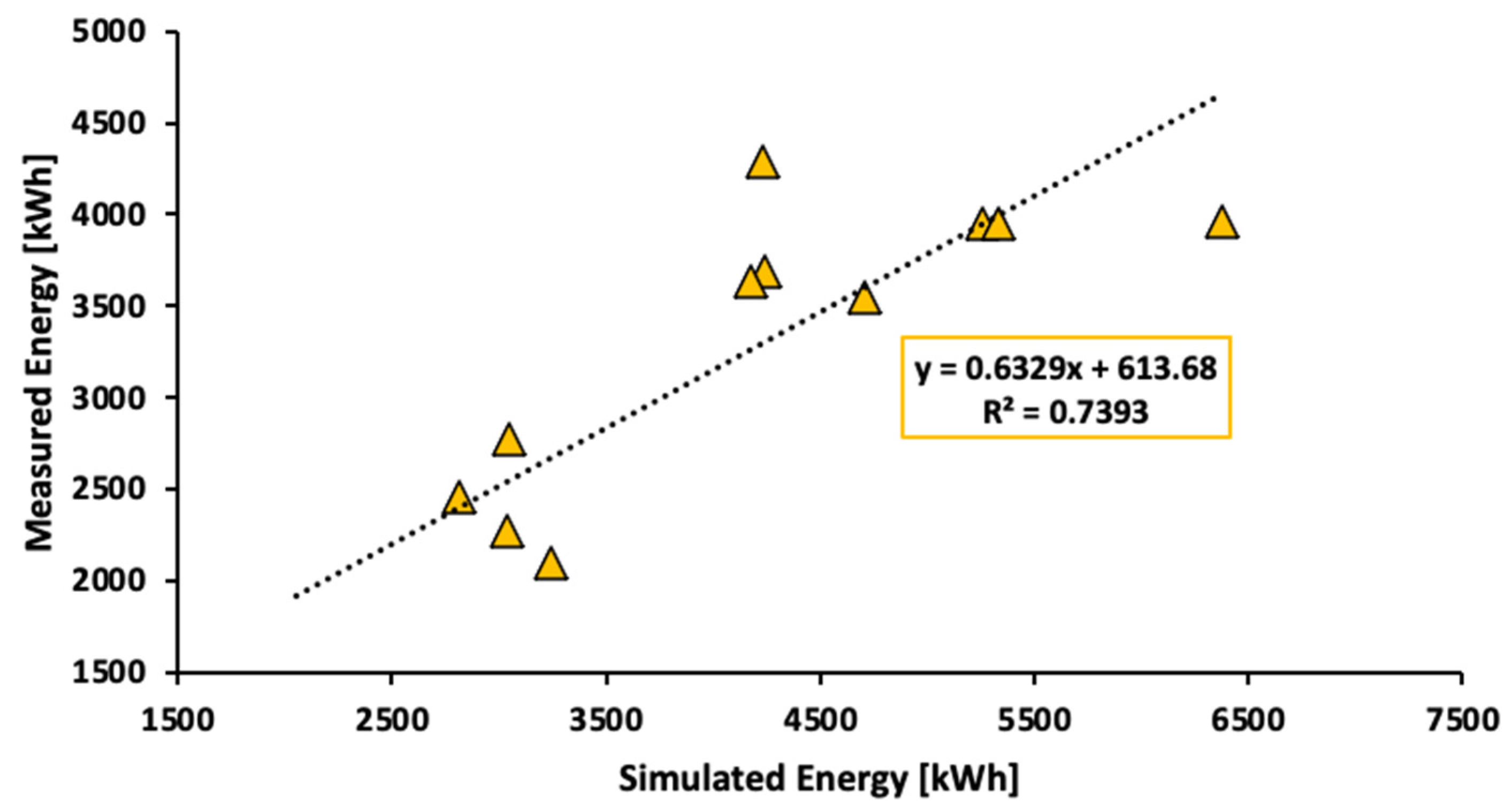
| Month | FIT Rate (JPY/kWh) | FIT Rate (JPY/kWh) |
|---|---|---|
| 2012 | 42 | 40 |
| 2013 | 38 | 36 |
| 2014 | 37 | 32 |
| 2015 | 33–35 | 27–29 |
| 2016 | 31 | 24 |
| 2017 | 28 | 21 |
| 2018 | 26 | 18 |
| 2019 | 24 | 14 |
| Month | Solar Irradiation | No of Rainy Days |
|---|---|---|
| January | 2.84 | 5 |
| February | 3.35 | 4 |
| March | 3.95 | 6 |
| April | 5.07 | 9 |
| May | 5.95 | 6 |
| June | 4.53 | 17 |
| July | 3.98 | 14 |
| August | 4.98 | 11 |
| September | 4.03 | 11 |
| October | 2.84 | 14 |
| November | 2.71 | 6 |
| December | 1.92 | 6 |
| Item | Information |
|---|---|
| PV Module Maker | Panasonic |
| PV Module Number | VBMS245 |
| PV module Power Output | 245 W |
| PV module Vmp | 30.1 V |
| PV module Imp | 8.23 A |
| PV module Voc | 37.1 V |
| PV module Isc | 8.80 A |
| Number of Inverters | 2 |
| Number of PV Modules | 168 |
| Year of installation | 2012 |
| Month | Energy | Energy | Energy | CUF (%) | PR (%) | |||||
|---|---|---|---|---|---|---|---|---|---|---|
| January | 2372 | 2268 | 3042 | 1.9 | 2.8 | 1.83 | 7.59 | 64.6 | 0.06 | 0.93 |
| February | 2461 | 2100 | 3244 | 2.1 | 3.3 | 1.86 | 7.02 | 55.6 | 0.32 | 1.16 |
| March | 4388 | 4292 | 4236 | 3.5 | 3.9 | 3.44 | 14.3 | 87.1 | 0.07 | 0.43 |
| April | 4863 | 3953 | 5256 | 4.0 | 5.0 | 3.28 | 13.2 | 64.6 | 0.75 | 1.03 |
| May | 5758 | 3965 | 6376 | 4.6 | 5.9 | 3.18 | 13.2 | 53.4 | 1.45 | 1.34 |
| June | 4522 | 3543 | 4707 | 3.7 | 4.5 | 2.94 | 11.8 | 64.7 | 0.81 | 0.79 |
| July | 3783 | 3693 | 4243 | 3.0 | 3.9 | 2.96 | 12.3 | 74.8 | 0.07 | 0.92 |
| August | 4294 | 3951 | 5334 | 3.4 | 4.9 | 3.17 | 13.2 | 63.6 | 0.28 | 1.53 |
| September | 4023 | 3632 | 4174 | 3.3 | 4.0 | 3.01 | 12.1 | 74.8 | 0.32 | 0.69 |
| October | 3008 | 2768 | 3047 | 2.4 | 2.8 | 2.23 | 9.26 | 78.0 | 0.19 | 0.43 |
| November | 2609 | 2461 | 2811 | 2.1 | 2.7 | 2.04 | 8.23 | 75.2 | 0.12 | 0.54 |
| December | 1787 | 1446 | 2052 | 1.4 | 1.9 | 1.16 | 4.83 | 60.5 | 0.27 | 0.48 |
| Month | ||||
|---|---|---|---|---|
| January | 2268 | 3042 | 90,720 | 121,680 |
| February | 2100 | 3244 | 84,000 | 129,759 |
| March | 4292 | 4236 | 171,680 | 169,434 |
| April | 3953 | 5256 | 158,120 | 210,229 |
| May | 3965 | 6376 | 158,560 | 255,029 |
| June | 3543 | 4707 | 141,720 | 188,299 |
| July | 3693 | 4243 | 147,720 | 169,724 |
| August | 3951 | 5334 | 158,040 | 213,350 |
| September | 3632 | 4174 | 142,280 | 166,962 |
| October | 2768 | 3047 | 110,720 | 121,873 |
| November | 2461 | 2811 | 98,440 | 112,427 |
| December | 1446 | 2052 | 57,840 | 82,086 |
| Location | Installed Capacity (kWp) | Monitored Period | Reference | |||
|---|---|---|---|---|---|---|
| Greece, Crete | 171.1 | 2007 | 3.66 | 15.3 | 67.4 | [14] |
| Chile, Punta Arenas | 8.2 | 2018 | 3.60 | 15.1 | 89 | [7] |
| Ireland, Dublin | 1.72 | 2008–2009 | 2.40 | 16.1 | 81.5 | [35] |
| India, Eastern | 11.2 | 2014–2015 | 3.67 | 15.3 | 78 | [33] |
| Oman, Muscat | 1.4 | 2012 | 4.10 | 17 | 65 | [39] |
| India, Chandigarh | 200 | 2019 | 3.70 | 15.2 | 71.3 | [32] |
| Italy, Lecce | 960 | 2012-2015 | 3.80 | 15.6 | 84.4 | [31] |
| Japan, Tochigi | 40.16 | 2019 | 2.59 | 10.6 | 68.1 | This study |
Publisher’s Note: MDPI stays neutral with regard to jurisdictional claims in published maps and institutional affiliations. |
© 2021 by the authors. Licensee MDPI, Basel, Switzerland. This article is an open access article distributed under the terms and conditions of the Creative Commons Attribution (CC BY) license (https://creativecommons.org/licenses/by/4.0/).
Share and Cite
Abdullah, G.; Nishimura, H. Techno-Economic Performance Analysis of a 40.1 kWp Grid-Connected Photovoltaic (GCPV) System after Eight Years of Energy Generation: A Case Study for Tochigi, Japan. Sustainability 2021, 13, 7680. https://doi.org/10.3390/su13147680
Abdullah G, Nishimura H. Techno-Economic Performance Analysis of a 40.1 kWp Grid-Connected Photovoltaic (GCPV) System after Eight Years of Energy Generation: A Case Study for Tochigi, Japan. Sustainability. 2021; 13(14):7680. https://doi.org/10.3390/su13147680
Chicago/Turabian StyleAbdullah, Ghoname, and Hidekazu Nishimura. 2021. "Techno-Economic Performance Analysis of a 40.1 kWp Grid-Connected Photovoltaic (GCPV) System after Eight Years of Energy Generation: A Case Study for Tochigi, Japan" Sustainability 13, no. 14: 7680. https://doi.org/10.3390/su13147680
APA StyleAbdullah, G., & Nishimura, H. (2021). Techno-Economic Performance Analysis of a 40.1 kWp Grid-Connected Photovoltaic (GCPV) System after Eight Years of Energy Generation: A Case Study for Tochigi, Japan. Sustainability, 13(14), 7680. https://doi.org/10.3390/su13147680







